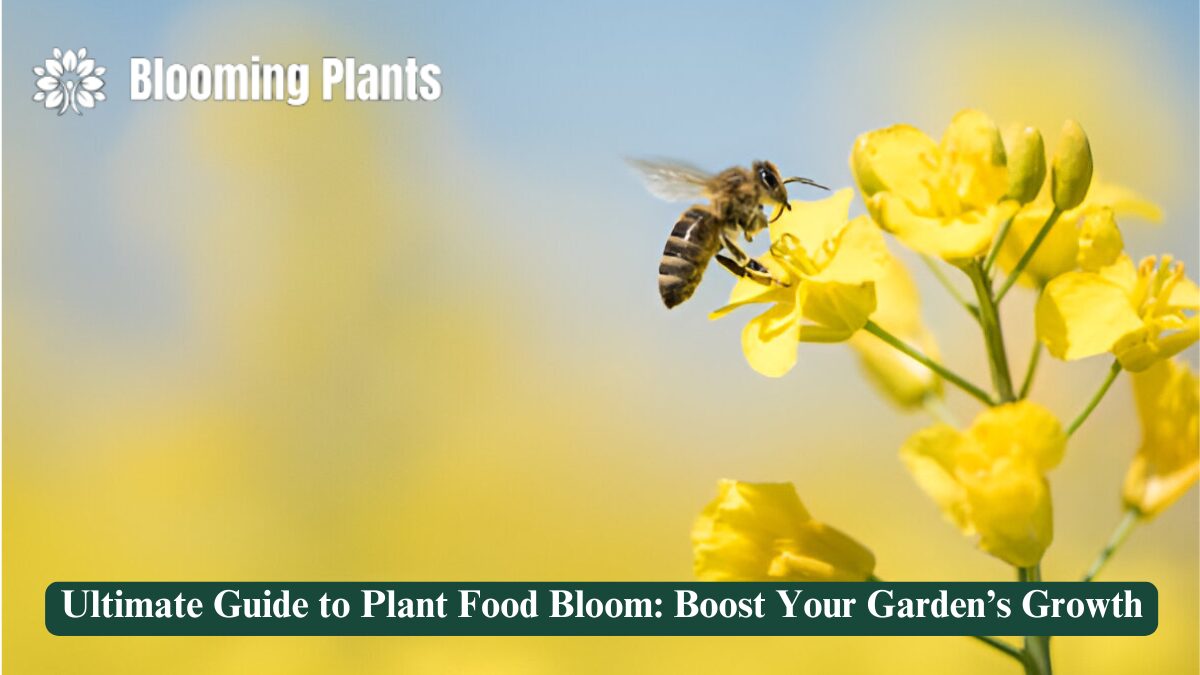Plant food bloom is the secret ingredient to lush, vibrant gardens and healthier plants. Understanding how it works and incorporating it effectively can elevate your gardening game. In this comprehensive guide, we’ll explore everything you need to know about plant food bloom what it is, how to use it, the science behind it, and tips for achieving the best results.
What is Plant Food Bloom?
Plant food bloom refers to fertilizers or nutrients specifically designed to promote flowering and fruit production in plants. These products are rich in essential nutrients like phosphorus and potassium, which play a key role in the flowering phase.
Key Nutrients in Plant Food Bloom
To understand plant food bloom better, it’s crucial to know its components:
- Phosphorus (P): supports root development and stimulates flower and fruit growth.
- Potassium (K): enhances overall plant health, improves resistance to stress, and aids in fruit and flower development.
- Micronutrients: Elements like magnesium, calcium, and iron support photosynthesis and plant metabolism.
How is Plant Food Bloom Different from Regular Fertilizer?
Regular fertilizers are balanced or designed for general growth, while bloom fertilizers focus on the flowering stage. Bloom products have a higher phosphorus-to-nitrogen ratio, ensuring energy is directed toward blossoms rather than foliage.
| Nutrient | Role in Growth | Bloom-Specific Function |
| Nitrogen (N) | Leaf and stem growth | Minimal use during bloom |
| Phosphorus (P) | Root development | Flower and fruit formation |
| Potassium (K) | Stress resistance | Improves flower quality |
The Science Behind Plant Food Bloom
Why do plants need specialized food for blooming?
During the flowering stage, plants shift their energy from growing leaves and stems to producing flowers and fruits. This metabolic change requires a different nutrient balance. Phosphorus helps initiate flowering, while potassium strengthens plant tissues and enhances flower colour and size.
How Does Plant Food Bloom Work?
Plant food bloom provides targeted nutrients to support photosynthesis, enzyme activity, and cell division—all critical processes for flowering. For example, potassium increases the uptake of water and nutrients, leading to healthier flowers.
Benefits of Using Plant Food Bloom
Using plant food bloom can transform your garden. Here are the top benefits:
- Enhanced Flower Production: Promotes abundant blooms with vivid colours.
- Improved Fruit Quality: Boosts size, taste, and nutritional value of fruits.
- Stronger Plants: Builds resilience against pests, diseases, and environmental stress.
- Optimized Growth: Ensures nutrients are used efficiently during the flowering phase.
Choosing the Right Plant Food Bloom
Types of Bloom Fertilizers
- Organic fertilizers: derived from natural sources like bone meal, fish emulsion, and compost.
- Synthetic fertilizers: manufactured chemicals with precise nutrient ratios.
- Liquid fertilizers: fast-acting and ideal for immediate nutrient delivery.
- Granular fertilizers: slow-release formulas for long-term feeding.
Key Factors to Consider
- Plant Type: Some plants have specific nutrient needs. For instance, roses thrive on high phosphorus.
- Soil Quality: Conduct a soil test to determine nutrient deficiencies.
- Growth Stage: Use bloom fertilizers only during the flowering phase.
| Fertilizer Type | Pros | Cons |
| Organic | Environmentally friendly | Slower results |
| Synthetic | Quick results | May harm soil health |
| Liquid | Easy application | Requires frequent use |
| Granular | Long-lasting | Less immediate impact |
How to Apply Plant Food Bloom
Step-by-Step Guide
- Read the label: Follow the manufacturer’s instructions for the correct dosage.
- Prepare the soil: Ensure soil is moist before application to prevent root burn.
- Apply Evenly: Distribute the fertilizer around the plant’s base.
- Water Thoroughly: Help nutrients reach the roots by watering after application.
- Monitor Growth: Observe plant health and adjust feeding as needed.
Tips for Optimal Results
- Use a watering can or spray bottle for liquid fertilizers.
- Avoid overfertilizing, which can harm plants.
- Apply during the early morning or late afternoon to prevent nutrient evaporation.
Common Mistakes to Avoid
- Overfeeding: Too much fertilizer can lead to nutrient burn.
- Ignoring Soil pH: A pH imbalance can hinder nutrient absorption.
- Using the Wrong Fertilizer: Not all bloom fertilizers suit every plant type.
- Skipping Watering: Watering ensures proper nutrient uptake.
Case Study: Revitalizing a Struggling Garden
The Challenge
A gardener noticed their tomato plants produced lots of leaves but few fruits. The issue? Excess nitrogen and insufficient phosphorus.
The Solution
Switching to a high-phosphorus plant food bloom formula transformed the garden. Within weeks, the plants showed more flowers, and fruit production improved significantly.
The Results
The gardener’s harvest increased by 40% after incorporating bloom fertilizer and monitoring soil pH.
DIY Plant Food Bloom Recipe
For a homemade solution, try this organic recipe:
- Ingredients:
- 1 cup bone meal (phosphorus source)
- 1 cup wood ash (potassium source)
- 1 gallon water
- Instructions:
- Mix bone meal and wood ash in water.
- Let the mixture sit for 24 hours.
- Strain and use the liquid to water plants.
Conclusion
Plant food bloom is a game-changer for gardeners aiming for vibrant flowers and bountiful harvests. By understanding the nutrients, application methods, and common pitfalls, you can maximize your garden’s potential. Whether you choose organic options, synthetic formulas, or DIY solutions, the right plant food bloom will bring your plants to life.
FAQ
Can I Use Plant Food Bloom on All Plants?
While most flowering and fruiting plants benefit from bloom fertilizers, leafy vegetables like lettuce may not need them.
How Often Should I Apply Bloom Fertilizer?
It depends on the product, but most recommend feeding every 1-2 weeks during the flowering phase.
What are the Signs of Over-Fertilization?
Yellowing leaves, brown tips, and salt buildup on the soil surface are common signs.

